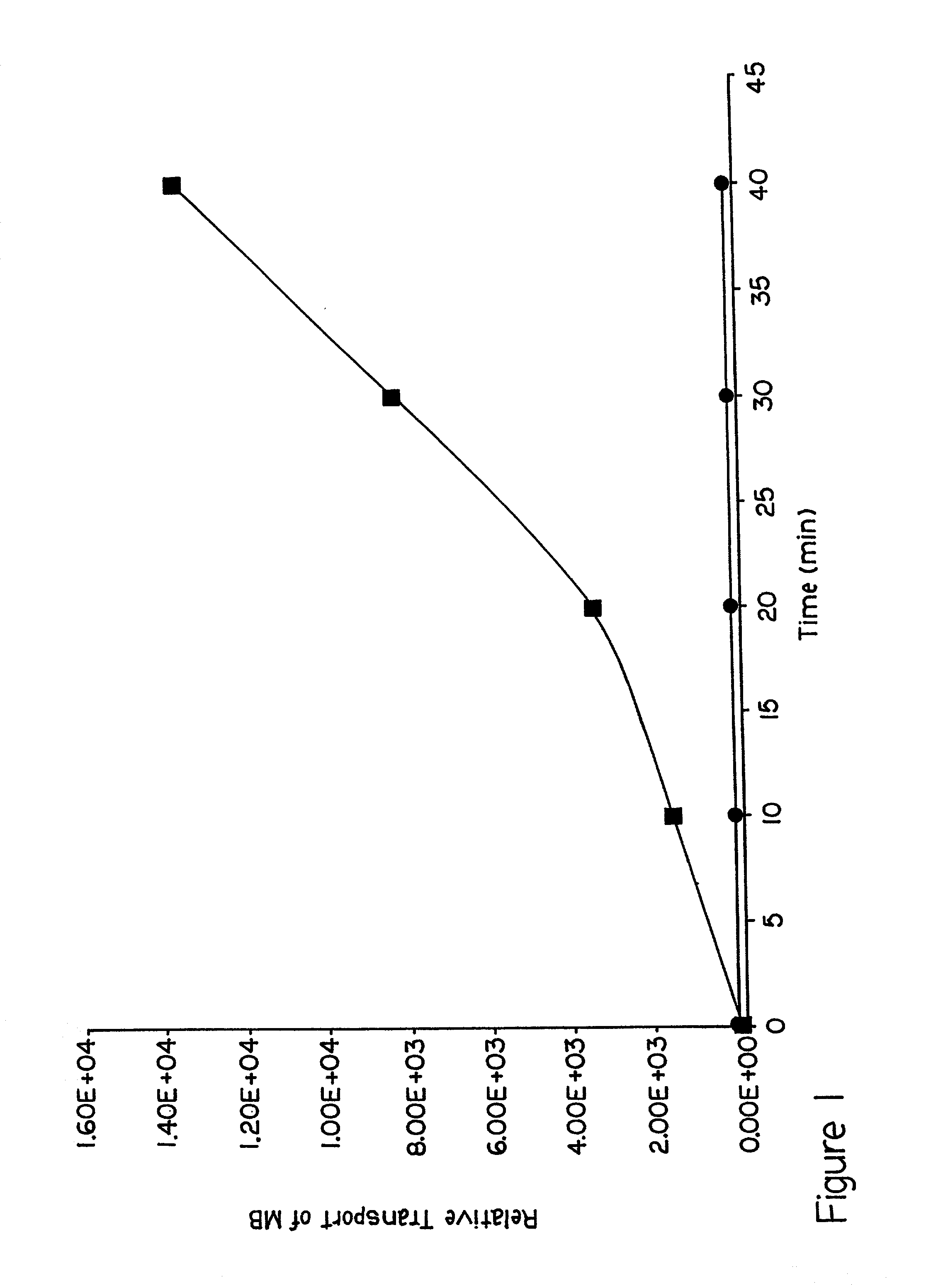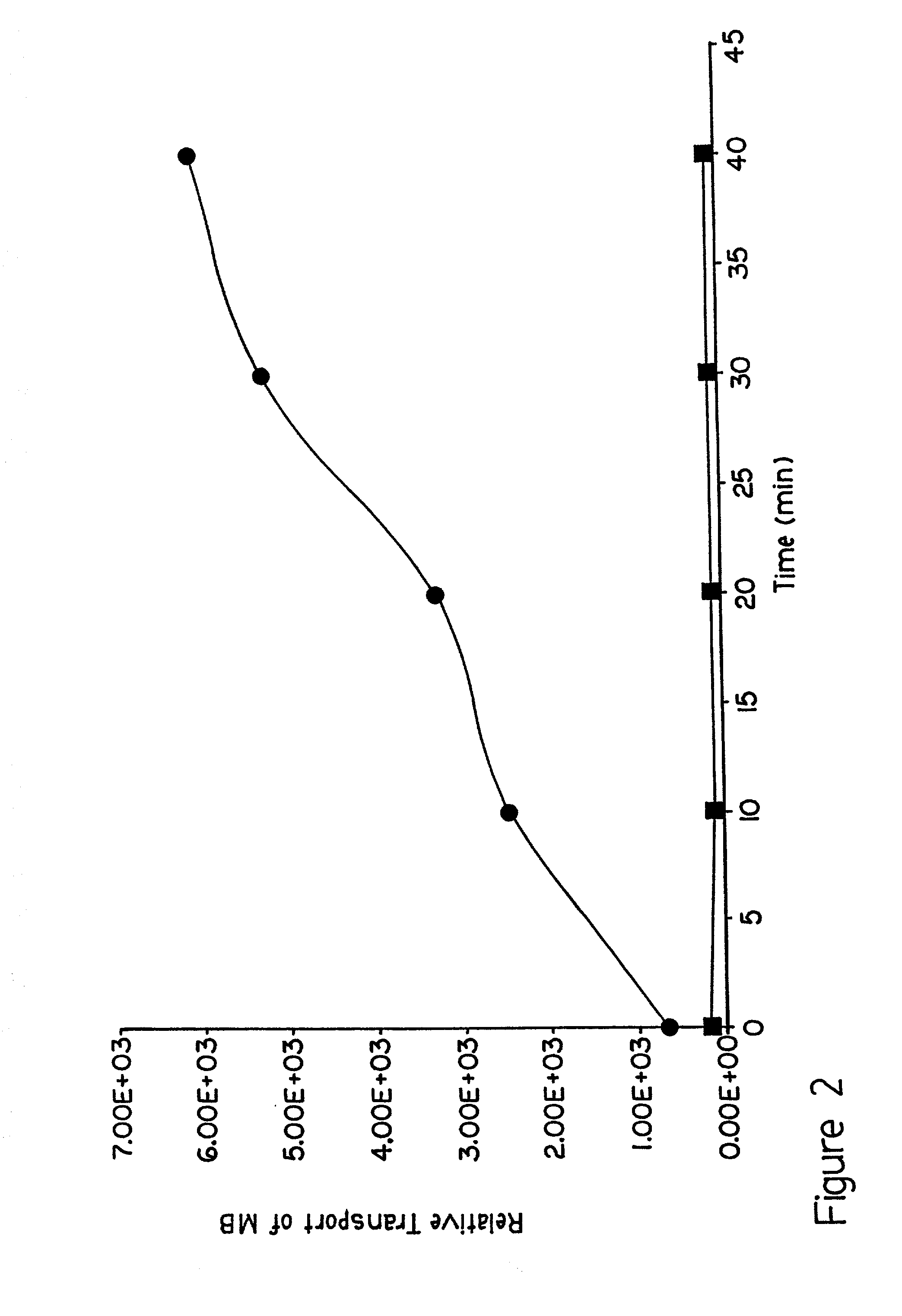Method for transdermal or intradermal delivery of molecules
- Summary
- Abstract
- Description
- Claims
- Application Information
AI Technical Summary
Problems solved by technology
Method used
Image
Examples
example 2
[0064] This embodiment demonstrates the effect of lipid formulations on the transport of charged and uncharged dextrans of varying molecular weights. To illustrate this embodiment, the transport of FITC-dextrans of molecular weights 3,900, 9,000, and 154,200 was measured in the Hanson Vertical Diffusion chamber as described in Example 1. Lipid formulation (DOPG:DOPC 1:1, 10 mg / ml) was added to the upper donor chamber along with measured amounts of FITC-dextrans of different molecular weights. Negative pulses, 1 ms duration were applied to the upper (donor) chamber while the lower acceptor chamber was connected to a common ground. After pulse application, the chamber was left undisturbed for 15 min following which the buffer, containing dextrans transported through the SC, was withdrawn from the lower (acceptor) chamber with the help of a syringe. The total buffer was concentrated to 3 ml in a centrifuge vacuum concentrator and the amount of FITC-dextran in the buffer determined by m...
example 3
[0065] This embodiment demonstrates that the presence of lipid formulation affects the lifetime of pores formed by electroporation in the SC layer of the skin. To illustrate this embodiment, the lifetime of the pores was determined by measuring the recovery of electrical resistance of the SC following electric pulse application. The measurements were carried out using a Hanson Vertical Diffusion chamber as described in Example 2. The resistance of SC was measured using a low voltage AC pulse train. First, the decrease in SC resistance following the application of 1 to 180 pulses of 150 V was measured in the absence and presence of added lipid formulation (DOPG:DOPC 1:1). The results are shown in FIG. 7. The decrease in the SC resistance was greatest after the first few pulses. Subsequent pulses caused only a small additional decrease in the resistance. The decrease in the resistance of the SC in the presence of added lipids was greater than that in the absence of the lipids. After t...
example 4
[0068] This embodiment describes the method of the present invention in situ. A molecule to be delivered is mixed with a liposomal composition comprising, e.g., DOPG:DOPC 1:1, 10 mg / ml, in a common buffer. The amount of molecule added to the liposomal composition will be determined by the desired concentration of molecule to be delivered. The molecule / lipid mixture is introduced into, e.g., a reservoir in an electrical patch electrode device, having surface-type electrodes. A human subject is prepared by removing the hair from a suitable skin site, such as the arm. The patch electrode is applied to the delivery site and the molecule / lipid mixture is applied to the skin. Single or multiple cycles of electroporation are performed (from about 1 to about 300 pulses), at about 50-100 volts and about 1 Hz, with a pulse length of 1-20 ms. Passive diffusion is allowed between pulsing cycles or between pulses during the cycle and the molecule is delivered.
PUM
| Property | Measurement | Unit |
|---|---|---|
| Length | aaaaa | aaaaa |
| Time | aaaaa | aaaaa |
| Time | aaaaa | aaaaa |
Abstract
Description
Claims
Application Information
 Login to View More
Login to View More - R&D
- Intellectual Property
- Life Sciences
- Materials
- Tech Scout
- Unparalleled Data Quality
- Higher Quality Content
- 60% Fewer Hallucinations
Browse by: Latest US Patents, China's latest patents, Technical Efficacy Thesaurus, Application Domain, Technology Topic, Popular Technical Reports.
© 2025 PatSnap. All rights reserved.Legal|Privacy policy|Modern Slavery Act Transparency Statement|Sitemap|About US| Contact US: help@patsnap.com



